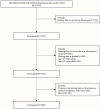The association of visceral and subcutaneous fat areas with phenotypic age in non-elderly adults, mediated by HOMA-IR and HDL-C
- PMID: 39856735
- PMCID: PMC11761183
- DOI: 10.1186/s12944-025-02446-4
The association of visceral and subcutaneous fat areas with phenotypic age in non-elderly adults, mediated by HOMA-IR and HDL-C
Abstract
Background: Ageing results in diminished adaptability, as well as declines in physiological and psychological functions and resilience. The epigenetic clock 'Phenotypic Age' (PhenoAge) represents 'preclinical ageing'. Phenotypic Age Acceleration (PhenoAgeAccel) is defined as the residual from a linear regression model predicting PhenoAge on the basis of chronological age. Abdominal subcutaneous adipose tissue, visceral adipose tissue, the Homeostasis Model Assessment of Insulin Resistance (HOMA-IR), and high-density lipoprotein cholesterol (HDL-C) have all been shown to correlate with ageing; however, the connections between these factors and PhenoAge are still insufficiently investigated.
Methods: Data for this study were sourced from the National Health and Nutrition Examination Survey (2015-2018), comprising 2580 participants. Complex survey designs were considered. To examine the association between body fat area and PhenoAgeAccel, logistic regression was applied. Additionally, subgroup analysis was used to identify variations in population characteristics. The dose‒response relationship between body fat area and PhenoAgeAccel was determined via restricted cubic spline analysis. Mediation and interaction analyses were further employed to investigate the roles of the HOMA-IR and HDL-C in this association.
Results: In nonelderly adults, the relationships between body fat area and PhenoAgeAccel differed chronological age. For abdominal subcutaneous fat area (SFA), this relationship was nonlinear in individuals aged 18-44 years and 45-59 years, with thresholds of 2.969 m² and 3.394 m², respectively. In contrast, a nonlinear relationship of visceral fat area (VFA) with PhenoAgeAccel was observed in individuals aged 18-44 years, while this relationship was linear in individuals aged 45-59 years, with thresholds of 0.769 m² and 1.220 m², respectively. Mediation effect analysis revealed that the HOMA-IR had a more pronounced mediation effect in individuals aged 18-44 years, accounting for 13.4% of the relationship between VFA and PhenoAgeAccel and 6.9% of the relationship between SFA and PhenoAgeAccel. Conversely, HDL-C had a greater mediating effect in individuals aged 45-59 years, accounting for 21.7% of the relationship between VFA and PhenoAgeAccel and 11.6% of the relationship between abdominal SFA and PhenoAgeAccel. HOMA-IR ≥ 2.73 or VFA > 0.925 m², as well as HOMA-IR ≥ 2.73 or abdominal SFA > 3.137 m², accelerated PhenoAge, whereas 1.60 < HDL-C ≤ 3.90 mmol/L combined with abdominal SFA ≤ 3.137 m² or VFA ≤ 0.925 m² decelerated PhenoAge.
Conclusion: In this study, the nonlinear relationships among abdominal SFA, VFA, and PhenoAgeAccel were elucidated, while characteristic thresholds across different age groups were identified. The results of this study emphasize the complex influence of fat distribution on the ageing process and refine the roles of HOMA-IR and HDL-C in various age cohorts. These findings provide a biological basis for future screening for accelerated ageing and appropriate intervention in high-risk populations and offer valuable insights for guiding personalized clinical interventions and health management strategies.
Keywords: Adipose tissue; Biological ageing; Senescence; Subcutaneous fat; Visceral fat.
© 2025. The Author(s).
Conflict of interest statement
Declarations. Ethical approval: The data for this study were obtained from the National Health and Nutrition Examination Survey (NHANES) database, National Center for Health Statistics (NCHS) Ethics Review Board (ERB) and the formal review bodies have approved each NHANES study protocol. Competing interests: The authors declare no competing interests.
Figures







Similar articles
-
Dyslipidemia and aging: the non-linear association between atherogenic index of plasma (AIP) and aging acceleration.Cardiovasc Diabetol. 2025 Apr 25;24(1):181. doi: 10.1186/s12933-025-02695-8. Cardiovasc Diabetol. 2025. PMID: 40281579 Free PMC article.
-
Effects of Aging on Visceral and Subcutaneous Fat Areas and on Homeostasis Model Assessment of Insulin Resistance and Insulin Secretion Capacity in a Comprehensive Health Checkup.J Atheroscler Thromb. 2016;23(2):207-15. doi: 10.5551/jat.30700. Epub 2015 Sep 28. J Atheroscler Thromb. 2016. PMID: 26412583
-
Contribution of subcutaneous fat accumulation to insulin resistance and atherosclerosis in haemodialysis patients.Nephrol Dial Transplant. 2009 Nov;24(11):3474-80. doi: 10.1093/ndt/gfp290. Epub 2009 Jun 17. Nephrol Dial Transplant. 2009. PMID: 19535435
-
Relationship between abdominal fat accumulation and insulin resistance in hemodialysis patients.Hypertens Res. 2008 Jan;31(1):83-8. doi: 10.1291/hypres.31.83. Hypertens Res. 2008. PMID: 18360022
-
Visceral adiposity and inflammatory bowel disease.Int J Colorectal Dis. 2021 Nov;36(11):2305-2319. doi: 10.1007/s00384-021-03968-w. Epub 2021 Jun 9. Int J Colorectal Dis. 2021. PMID: 34104989 Review.
Cited by
-
Association between daily sitting time and accelerated aging in women: double mediation effects of systemic immune-inflammation index and creatinine.Aging Clin Exp Res. 2025 Jul 3;37(1):205. doi: 10.1007/s40520-025-03116-2. Aging Clin Exp Res. 2025. PMID: 40610691 Free PMC article.
-
Dyslipidemia and aging: the non-linear association between atherogenic index of plasma (AIP) and aging acceleration.Cardiovasc Diabetol. 2025 Apr 25;24(1):181. doi: 10.1186/s12933-025-02695-8. Cardiovasc Diabetol. 2025. PMID: 40281579 Free PMC article.
References
-
- Partridge L, Deelen J, Slagboom PE. Facing up to the global challenges of ageing. Nature. 2018;561:45–56. - PubMed
-
- Khaltourina D, Matveyev Y, Alekseev A, Cortese F, Ioviţă A. Aging fits the Disease Criteria of the International classification of diseases. Mech Ageing Dev. 2020;189:111230. - PubMed
-
- Kong L, Ye C, Wang Y, Hou T, Zheng J, Zhao Z et al. Genetic Evidence for Causal Effects of Socioeconomic, Lifestyle, and Cardiometabolic Factors on Epigenetic-Age Acceleration. Le Couteur D, editor. The Journals of Gerontology: Series A. 2023;78:1083–91. - PubMed
MeSH terms
Substances
LinkOut - more resources
Full Text Sources
Medical

